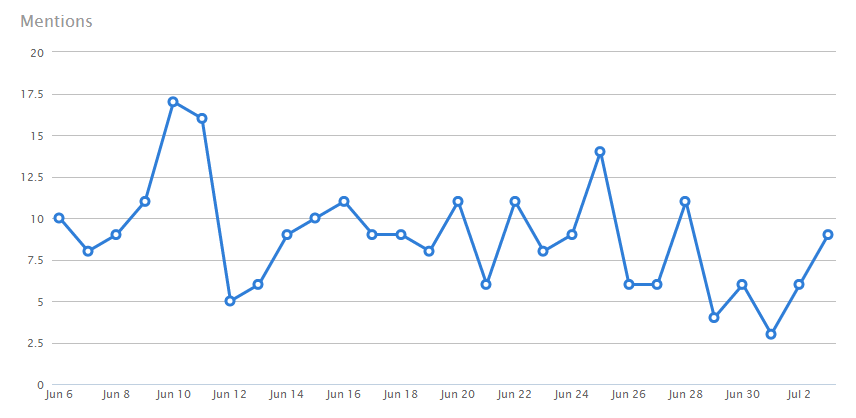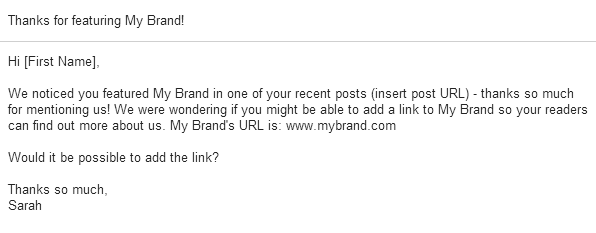Monitoring your brand for unlinked mentions is beneficial for the following reasons:
-
Find the issues
Monitoring mentions of your brand garners thousands of unsolicited reviews from your customers. While it’s easy to see unhappy customers on social platforms like Twitter and Facebook, all too often we forget that some people aren’t always going to bring issues to your attention. Instead, they post their frustration on their blog and you have no way of trying to make it right. Finding those mentions not only fixes that person’s issue, it places your company in that small percentage of brands that consistently try to make it right.
-
Find your fans
Yes, you have thousands (maybe millions) of fans on Facebook and followers on Twitter because there is nothing easier than clicking that ‘Like’ or ‘Follow’ button. The people who are really pushing your brand are those people who write about you, share your product/service, and publish it for the (online) world to see. If those people are taking the time to do that without being asked or compensated, it is important to form a relationship with them or at least let them know you appreciate their loyalty. What’s harder: trying to persuade people to feature your brand OR finding the people who are already doing it?
-
Get ideas for new features and/or content
You may have an idea of what your customers are using your service/product for but they may have a completely different idea. If we don’t monitor how our customers are using our service, where they have road blocks, and what features they wish we had, we will never be able to keep up. Monitoring brand mentions allows you to read through content that outlines how customers use your service or product and could spark new ideas for content, features, or even simply point out a bug your were unaware of.
-
Acquire new links
I put this last because I think a link is great but the three points above are the most important. Because these are unlinked mentions, it is extremely easy to ask the writer to add in a link to your domain. As long as the content is of positive sentiment, most of the time the writer will be happy to add the link to their post.
In this post, I will walk you through a simple strategy that I use to monitor my brand, find unlinked mentions, acquire that link, and build a relationship. Before you get too overwhelmed and stop reading, let me tell this:
I spend 2 hours a week doing this and I acquire an average of 10 links, and build at least 10 new relationships - it’s easy and it’s worth a shot.
Step 1: Find the unlinked mention
Using Moz’s Fresh Web Explorer tool, I was able to build a custom search operator to find unlinked mentions of my brand. When building out your custom search operator, you will want to follow this outline:

Once you click ‘Find Mentions’ it will pull up every site that has mentioned your brand without linking to your domain. It only goes back four weeks but that’s okay because this strategy is all about timing - the sooner you catch the unlinked mention, the easier it is to get a link added.

Step 2: Export the URLs and start reading!
Obviously there will be a bit of noise when pulling this data. A few things that you will run into are:
-
Affiliate links - Fresh Web does not differentiate these so they are not technically unlinked mentions.
-
Incorrect URL spellings - use the URL Misspelling outreach template to get that fixed!
-
Press releases - because press releases are heavily branded, you will run into these from time to time.
-
Depending on your brand and industry, you may find other noise that makes vetting these sites a difficult.
When going through the unlinked mentions be sure to look out for sentiment of the content, how they are using your product or service, and how their audience is engaging with that content (read the comments). Take notes of any major sites that you might want to form a relationship with, any journalists who often write about your brand, or major issues your customers are having.
Step 3: Reach out to prospects
Once you have your list of sites that you would like to reach out to, it is important to include the following elements in your message:
-
A thank you for featuring or mentioning your brand
-
The URL of the post where the unlinked mention exists (don’t make them take the extra step in trying to go back and find the post)
-
The URL of your domain
For this strategy, I use the following outreach message:

For reference, I have sent this message to 160 different bloggers and I received 90 responses - that is a little over a 55% response rate. From those 90 responses, at least 75% of them add the link.
Step 4: Build the relationship
Some example responses I have received are:
-
“Absolutely! I thought I had actually done it.”
-
“Sure! I will do that right now. I love you guys!”
-
“Of course… I am a huge fan!”
These people have now professed their love for my brand twice - once in their blog post and once in their email to me. I would be silly to let this kind of loyalty go to waste so I always follow up with an email asking them take part in a partnership opportunity we are currently working on or might be working on in the future. At the very least, I always ask them if they would be interested in continuing a relationship with us.

Takeaways
-
The reason that this was so successful is that the people we were reaching out to were already fans of the brand. Because of this, it was easy to acquire the link and the relationship.
-
Time is of the essence. Catching the unlinked mention as quickly as possible will help you acquire the link and journalists or bloggers are always impressed when you catch their feature as soon as it goes live.
-
The outreach message was short, thanked them for the article, and proposed an easy solution.
-
The follow-up message opened the door for a future partnership and allowed the blogger access to someone if they ever have questions or concerns.
If you have any other easy strategies for brand monitoring, let me know in the comments or on Twitter: @TheGurbs


